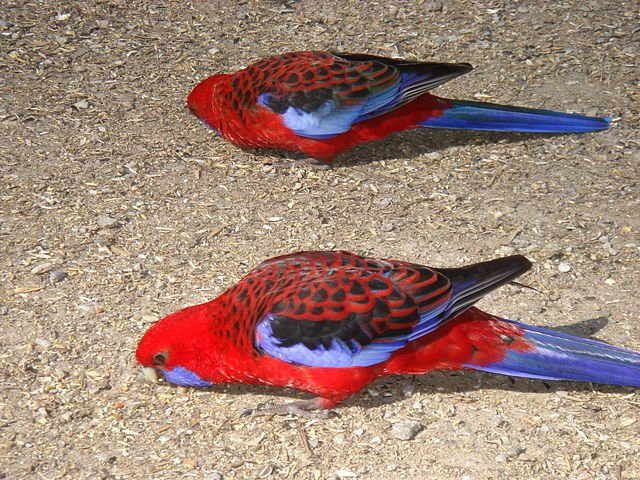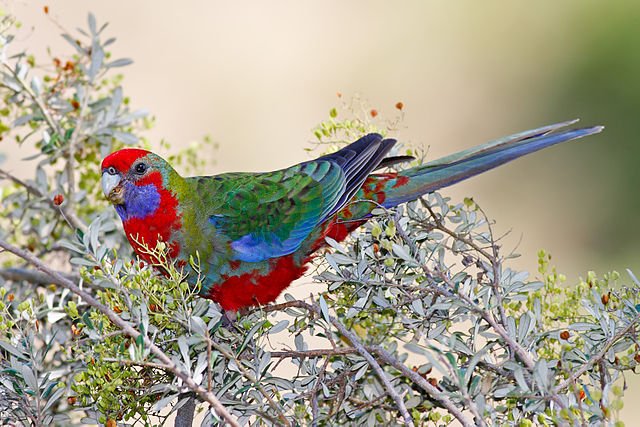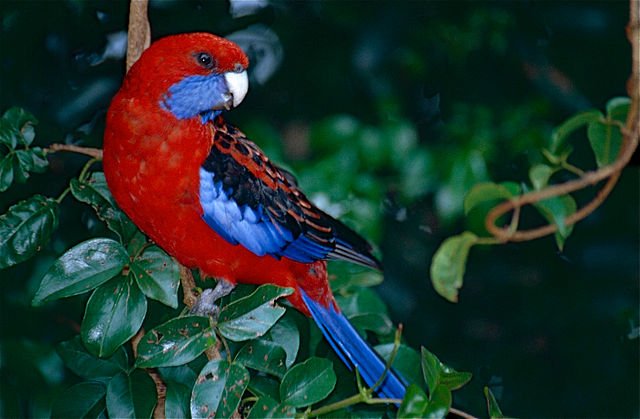Mutations of birds, especially parrots, is a vast and interesting subject, and many attempts are being carried out around the world, by aviculturists, to produce more and more color mutations. Today, we talk about mutations of crimson rosella, a bird belongs to the family of parrots, which is endemic to eastern and southeastern Australia.
What is a mutation?
Most of the time all the animals within a particular species resemble each other. But, once in a blue moon, an animal can be genetically different from the rest of the species. This difference is called a mutation, which is a change of appearance of an animal due to the alterations happens in the DNA sequence.
It can occur because of the mistakes during the process of copying the DNA or due to environmental factors. Usually, a wild mutation work against the animal, and therefore it rarely survives long enough to reproduce and pass the mutation to its offspring. For example, a giraffe with a short neck would starve to death, because it cannot feed itself. But, sometimes a mutation can work in favor of the animal, and lives long enough to breed and pass its genes to its next generation.
When it comes to bird mutations, especially parrots, due to their beautiful color combinations, they create unique and stunning genetic diversity. A bird mutation can occur in the wild as well as in captivity. Actually, mutations in captivity can survive longer comparing to wild mutations, because birds in captivity rarely face the challenges that they meet in the wild.
Mostly, mutations in captivity are recessive or sex-linked. Once a new color mutation is found in aviaries, they breed more babies of that color, and then they are line bred. Linebreeding is a controlled method of inbreeding, which can help to isolate the gene and also to figure out the process of mutation (recessive, sex-linked, etc.).
More about Crimson Rosella Breeding.
https://parrotquaker.com/crimson-rosella-breeding-information/
The Crimson Rosella and its mutations
The crimson rosella is a beautiful, colorful, medium-sized parrot, which is native to the east and southeast Australia. Also, this species has been introduced to New Zealand and Norfolk Island, which is a small island located between Australia, New Zealand, and New Caledonia. Within these regions, it is most fond of mountain forests and gardens.
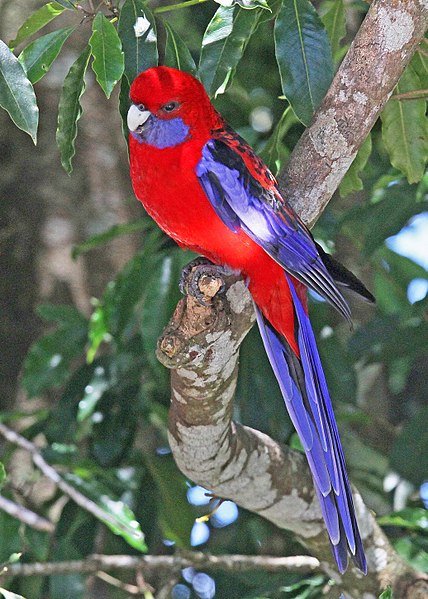
Picture from Wikipedia.org , Joseph C Boone / CC BY-SA (https://creativecommons.org/licenses/by-sa/4.0)
There are four types of subspecies identified today. They are P. elegans elegans, found in eastern Australia, P. elegans nigrescens, a visually similar but slightly smaller subspecies found in north-eastern Australia, a yellow subspecies, commonly called the “yellow rosella” found in south-eastern Australia along the Murray River, and the Adelaide Rosella, P. elegans subadelaidae, which is thought to be a hybrid of the red and yellow subspecies occurring where their ranges overlap.
The plumage of adult males is mostly red along with violet-blue cheeks and black nape, back, and secondary parts. Adult females also have the same appearance, except for its average small size and the greenish tinge to the upper side of the middle tail feathers. In contrast, juveniles have olive-green plumage excluding the parts of forehead, crown, upper check area, throat, parts of the upper breast, thighs and under tail-coverts.
In the natural habitat, these birds feed on mostly grass and tree seeds, however, they also feed on fruits, berries, flowers, and nectar. A good captivity diet of crimson rosella must consist of canary seed, a mixture of millets, sunflower, and safflower.
Many crimson rosellas feed on the ground floor, therefore they normally spend a lot of time on the aviary floor. Because of that, they tend to be affected by worms and parasites. Therefore, a strict parasite control regime is essential to keep their health in a high level. Normally, a healthy crimson rosella lives 20 years or longer. These crimson rosellas are great aviary companions, due to their attractive and quiet nature.
Recently, many mutations of crimson rosellas have appeared in aviculture. Mainly there are blue, yellow, lutino, cinnamon, orange, pastel, and pied mutations. These are primary color mutations, which involve only a single mutation. Also, there are different color combinations created through the modifying of genes, such as silver (blue and yellow), albino (blue and lutino), and black-eyed white (blue, yellow, cinnamon, and pastel).
Mutations can be sex-linked, recessive, or dominant. Blue, yellow, recessive pied and pastel belongs to the recessive category of mutations, whereas sex-linked mutations only include lutino and cinnamon. However, the only dominant mutation found within crimson rosellas is the dominant pied.
Read more about Crimson Rosella Gender differences.
Recessive mutations
For a crimson rosella to be visual for a recessive mutation, both of its parents must carry that mutation. Let’s see the following set of examples of pairing.
⦁ Cock: Blue
Hen: Normal
Chicks: 100% Normal split Blue
⦁ Cock: Blue
Hen: Normal split Blue
Chicks: 50% Normal split Blue, 50% Blue
⦁ Cock: Blue
Hen: Blue
Chicks: 100% Blue
In the first example, all the chicks are Normal and split into Blue, because they only get their blue gene from only one parent. The second example produces 50% Normal split Blue and other half Blue. But, the ideal one is the third example, because it gives all of the chicks Blue mutations, as they get blue genes from both parents.
Sex-linked mutations
In fact, sex-linked mutations are different from others. Here, only cocks can be spilled for a sex-linked mutation. If a hen is of sex-linked mutation, she will be apparent for it, and therefore, a hen cannot be split into lutino or cinnamon. The following examples show how a sex-linked mutation is carried out.
⦁ Cock: Lutino
Hen: Normal
Chicks (Cocks): 100% Normal split Lutino
Chicks (Hens): 100% Lutino
⦁ Cock: Normal
Hen: Lutino
Chicks (Cocks): 100% Normal split Lutino
Chicks (Hens): 100% Normal
Normally, the cocks who have the visually sex-linked mutation, are very expensive. You can see why they are that expensive by looking into the above two examples of combinations. Moreover, the following combinations also produce sex-linked mutations.
⦁ Cock: Normal split Lutino
Hen: Lutino
Chicks (Cocks): 50% Normal split Lutino, 50% Lutino
Chicks (Hens): 50% Normal, 50% Lutino
⦁ Cock: Normal split Lutino
Hen: Normal
Chicks (Cocks): 50% Normal split Lutino, 50% Normal
Chicks (Hens): 50% Normal, 50% Lutino
Dominant mutations
The only dominant mutation that occurs in crimson rosellas is Dominant Pied. This mutation is very different from others because a bird cannot be split for a dominant mutation. That means, if a crimson rosella has a dominant mutation, it will definitely show it visually. The dominant mutation pairing can be carried out as follows.
⦁ Cock: single Factor (SF) Dominant Pied
Hen: Normal
Chicks: 50% SF Dominant Pied, 50% Normal
⦁ Cock: SF Dominant Pied
Hen: SF Dominant Pied
Chicks: 50% SF Dominant Pied, 25% Double Factor (DF) Dominant Pied, 25% Normal
There are many mutations of crimson rosellas, however, here we will only talk about three main mutations. They are blue, lutino, and cinnamon.
Blue Mutation
Blue mutation is considered as the simplest mutation, and it is a recessive mutation that blocks the production of yellow family pigments. We all know that the color green comes from the combination of blue and yellow colors. So, when the color yellow is not produced, only the blue color remains.
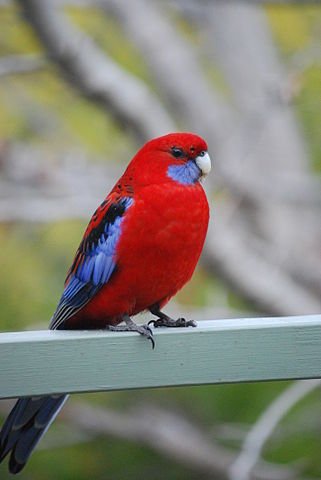
photo credit: John Poulakis from Australia / CC BY (https://creativecommons.org/licenses/by/2.0)
Hence, the areas that would usually appear in green are now blue in color, while others remain the same. In crimson rosellas, we know that immature birds have a lot of olive green color in their plumage that is lost as they mature. Therefore, young birds with the blue mutation have blue all over their body, however, as they mature, that blue color turns into a color of off white. The mature birds have an off white color in whichever parts that are in red color with original adult crimson rosella including the red scalloping in the back.
Lutino Mutation
Generally, the lutino mutation in many species is sex-linked, and it affects the production of grey family pigments. However, lutino crimson rosella can be either sex-linked or recessive. They show yellow or orange color variations, while their eyes are red and feet and beak are pink. Most of the time crimson rosellas appear in solid, vibrant yellow color. The majority of lutino crimson rosella is sex-linked, whereas recessive crimson rosella is a minority.
Cinnamon Mutation
The cinnamon mutation is also a sex-linked mutation, which prevents the conversion of brown pigment into black pigment. Because of that cinnamon mutation, crimson rosellas do not produce black or grey in any color shade. However, the effect of that differs from species to species.
There has been a misconception that there are recessive cinnamon crimson rosella mutations, because of the superficial similarity of cinnamon mutation with other recessive mutations. However, a cinnamon mutation can only be sex-linked, otherwise, it cannot be cinnamon. A cinnamon crimson rosella must not have a single grey or black pigment in it. This can only be identified by observing their feathers by a microscope or combined with a blue mutation, in that way grey or black pigments can be clearly seen.
In fact, new mutations are appearing for the crimson rosella day by day, thanks to the utmost effort of aviculturists. So, hopefully, we will get to see a few more new mutations of crimson rosella in the coming years as well.

